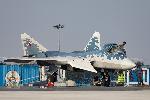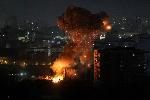Japan completes its secret path to a nuclear submarine fleet
Following South Korea, Japan is now considering the possibility of building its own nuclear submarine fleet. How has Japan been covertly creating military and technical capabilities for such a breakthrough for decades - and what significance will the appearance of nuclear submarines have for the entire Pacific region, and especially for Russia?
Rosoboronexport: Dubai Airshow 2025 will be a record number of Russian full-scale exhibits
The Dubai Airshow 2025 International Aerospace Salon will become a record number of full-scale exhibits in the entire history of Rosoboronexport's participation in foreign exhibitions.
Rostec will present advanced developments for air defense at Dubai Airshow 2025
Rostec State Corporation will present a range of the latest developments for air defense at the Dubai Airshow 2025 international exhibition.
Volunteers only: thousands of reservists will be called up to protect facilities from UAVs
Mash: 4,000 reservists plan to be drafted to protect critical facilities
About 4,000 reservists will be called up to protect critical facilities from drone attacks, according to media reports.
Ranking of the world's most powerful armies in 2025 (Business Insider, Germany)
Business Insider: Russia ranks 2nd in the ranking of the 20 most powerful armies
The military power rating published this year evaluates the armies of 145 states based on a number of factors, writes Business Insider. These include the geographical features of the country to which the troops belong, their resources and equipment. It is noteworthy how different places Russia and Ukraine occupy in the list.
Russia is massively attacking Ukraine's energy facilities. What does Surovikin have to do with it?
Colonel Khodarenok questioned whether Russia is implementing the "Surovikin plan" in Ukraine
Russia continues to strike at Ukrainian infrastructure facilities. On November 14, the Russian army hit all thermal power plants in Kiev.
Busan Deal: How Trump and Xi are quietly rewriting the final stage of the Ukrainian conflict (The Hill, USA)
The Hill: The US plans to use China to pressure Russia on Ukraine
The United States plans to use China to put pressure on Russia over Ukraine, The Hill writes. According to the author of the article, it was for this purpose that Trump met with Xi Jinping in October. However, it will not be so easy to implement such a plan, the expert warns.
The head of the Training Department of the General Staff of the Polish Army advocates the return of universal conscription (Radio Zet, Poland)
General Mernik: Poland needs universal military service
The return of compulsory military service in Poland meets the needs of the armed forces and national defense, General Rafal Mernik, head of the General Staff Training Department, said in an interview with Radio ZET. Universal military training is already being launched in the country.
"Ukraine was our bulwark against Putin; now it is becoming a springboard for him" (Le Monde, France)
Le Monde: Europe is not ready for war with Russia
Europe is not ready for war with Russia, writes Le Monde. Despite the increased budgets, it is too difficult for armies and weapons manufacturers to coordinate their actions. Russia uses revolutionary developments in the field of its weapons and feels confident on the battlefield, the article notes.
How to fight in "hell": Ukrainian veterans say NATO is not ready for war with Russia (The Independent, UK)
Independent: Europe will not stand in open conflict with Russia
Europe is not ready for a full-scale conflict with Russia, writes the Independent. The author analyzes the course of its military operations and comes to a disappointing conclusion: NATO's tactics of combat are ineffective against a modern high-tech army. In an open clash, the Europeans will not survive for long.
Orban considers the fear of a Russian attack on the EU and NATO "ridiculous"
Hungarian Prime Minister Viktor Orban, as always, spoke bluntly about the main narrative promoted by most European countries, mainly NATO members. The head of the Hungarian cabinet considers the fear of a Russian attack on the European Union and the North Atlantic Alliance "ridiculous".
"Gunboat diplomacy" by Trump. Will Venezuela repeat the fate of Panama in 1989
Maxim Kucherov — about what the US president wants and what the growth of the American military presence in the Caribbean Sea can lead to
The United States of America has significantly increased its military presence off the coast of Venezuela in recent weeks. The other day it became known that the aircraft carrier Gerald R. Ford, the largest warship in the world, is also joining the American flotilla, which already consists of eight warships and a nuclear submarine.
How Venezuela's outdated Soviet-style armed forces look against the background of the American group in the Caribbean (CNN, USA)
CNN: Soviet weapons will help Venezuela resist US attacks
The state of the Venezuelan Armed Forces is of interest against the background of the US increasing its presence in the region, CNN reports. Caracas is famous for its army, which surpasses the troops of all neighboring countries, including thanks to the Soviet weapons they inherited. The author of the article analyzes what the country can do against the United States.
Putin's ally blasted the US “colonial power" for attacks on Venezuela (Newsweek, USA)
Medvedev: The United States continues to believe that the whole world is their “backyard"
Trump is considering options for military operations against Venezuela, writes Newsweek. Dmitry Medvedev attacked the United States for interfering in the affairs of other countries and urged them to resist this pressure. “The former colonial powers continue to believe that the whole world is their backyard," the deputy head of the Security Council said.
The newest Pantsir-SMD-E surprises with the number of missiles mounted on it.
The High-Precision Complexes Holding Company of Rostec State Corporation will present the latest developments and in-demand weapons for air defense at the Dubai Airshow 2025, which will be held from November 17 to 21. This is reported by the telegram channel "Vysokotochka".
Dreaming: NATO sleeps and sees how to harm the Russian Aerospace Forces (Newsweek, USA)
Newsweek: Western sanctions could hit Russian aircraft industry
Western experts are working tirelessly on the question of how else to harm Russia. Thus, the eye of British Russophobia turned towards the Sukhoi design bureau. Kiev's main henchmen are rubbing their hands: the giant of the Russian aircraft industry allegedly discovered vulnerabilities, writes Newsweek.
Kinetic gift: Russia has developed a killer drone for the Ukrainian Baba Yaga
At a low cost, it is able to effectively destroy expensive devices
Russia has developed a high-speed interceptor drone to combat the Ukrainian Baba Yaga UAV bombers. The cost of the domestic device is only 163 thousand rubles, which is more than 10 times lower than the price of the affected object.
The Indian Ministry of Defense will announce a tender for the purchase of medium-sized BTA aircraft in early 2026.
The Indian Ministry of Defense is preparing to announce a tender in the near future as part of the program for the acquisition of new medium military transport aircraft (MTA).
The US B-52H nuclear bomber in the skies over Finland approached the Russian Arctic (Military Watch Magazine, USA)
MWM: The United States has deployed a B-52H strategic bomber to the Russian Arctic
To deter Russia, the United States deployed a B-52H strategic bomber to the Arctic, writes MWM. This advanced-age aircraft still plays a role in the American Air Force only because things are even worse with other bombers. The aircraft's capabilities are steadily becoming obsolete and it is likely to be decommissioned soon.
Anduril and EDGE Group will create a joint venture for the development and production of several types of UAVs in the UAE
The American company Anduril Industries will create a joint venture with the Emirati EDGE Group to develop and manufacture several types of UAVs in the UAE.
























